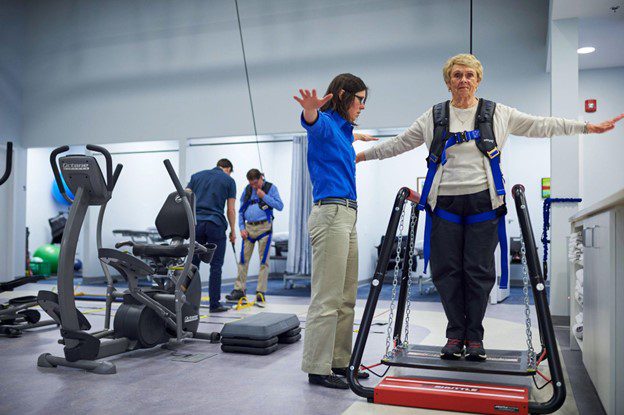How Can Balance Therapy Help You?

Balance problems can make it difficult for people to maintain a stable posture and keep upright while standing, walking, and sitting. Balance problems are more common in older adults and are the one of the most common reasons they seek help from a doctor. If balance problems are left untreated, they can lead to falls and injury. Physical therapy is a great way to improve your balance, no matter your age. Many clinics perform balance testing to help develop treatment plans to help improve strength, stability, and movement of people with balance issues.
What Are Balance Problems?
A balance problem exists when a person has difficulty keeping a stable and upright posture during movement or while sitting still. Some causes of balance problems include:
- Muscle weakness
- Joint stiffness and decreased movement
- Inner ear problems
- Lack of physical activity or too much sitting
- Aging
- And more
Balance problems can also be caused by medical conditions, such as:
- Stroke
- Parkinson disease
- Multiple Sclerosis
- Traumatic brain injury
- Arthritis
- Diabetes
- And more
When one or more of these five systems in the body do not function properly, a balance problem can occur:
- Vision: poor vision can result from aging, eye tracking problems, or eye diseases.
- Inner ear: The part of the inner ear responsible for balance is the vestibular system. Inner ear problems can develop from trauma, aging, poor nutrition or disease.
- Muscular system: Muscle strength and flexibility can decline due to age, lack of exercise, disease, or too much sitting.
- Proprioception: Body-position sense can become abnormal due to trauma or disease.
- Circulation: A sudden drop in blood pressure when a person sits or stands up can make a person feel dizzy or lightheaded. Circulation problems can be caused by dehydration, heart problems, or various diseases.
A person may not be able to maintain or correct their balance if:
- One or more of the senses is not sending correct signals to the brain
- The muscles cannot carry out specific movements
How Does It Feel?
A person with balance problems may experience:
- Dizziness or vertigo (a spinning sensation)
- Falling or feeling as if you are going to fall
- Teetering when trying to stand up, or staggering, tripping, swaying or stumbling when walking
- Lightheadedness, faintness, or a floating sensation
- Blurred vision
How Is It Diagnosed?
Seeing a physical therapist will allow them to conduct a full evaluation that includes talking about your health history. Your physical therapist will ask you detailed questions about your condition, including:
- How often do you have problems with your balance?
- What are you doing when you experience balance problems?
- Does the room spin, or do you feel off-balance?
- How many times have you fallen within the past year?
- What medications do you take?
- And more
Your physical therapist will perform test to check your overall ability in areas like:
- Movement
- Strength
- Coordination
- Visual Tracking
- Balance
Your physical therapist may work with your doctor or other health care providers in order to rule out other conditions.
How Can a Physical Therapist Help?
Organizations that have a balance training program or other PT programs like vestibular balance or gait training therapy, are ideally suited to help with balance issues. Physical therapists offer many different options and equipment to help treat balance problems based on each person’s needs. They evaluate many systems of the body, including:
- Muscles and joints
- The inner ear
- Eye tracking ability
- Skin sensation
- Circulation
- And more
Physical therapists are experts in movement and will prescribe movement techniques and exercises to improve your condition. Exercises may include those for:
- Strengthening
- Stretching
- Position awareness
- Inner ear retraining
- Visual tracking
Your physical therapist can help treat your balance problems by identifying their causes. They will design specific treatment for your needs, challenges and goals. They will also provide you challenges at home.

Oftentimes, patients may be afraid of falling. Many physical therapists have specific equipment for patients that may be afraid of falling and hurting themselves. Many different physical therapy locations now use the Solo-Step safety overhead system, to assist patients who may fall during therapy or who have a fear of falling. The Solo-Step overhead track and harness system consists of an aluminum track attached to the physical therapy location’s ceiling. The patient wears a harness and lanyard that attaches to the aluminum track to prevent them from falling and injuring themself. The Solo-Step overhead track system provides patients with benefits such as:
- Reduced fear of falling
- Increased confidence
- Enhanced mobility
- Improve balance
- Improved strength
- And more

What Kind of Physical Therapist Do I Need?
It’s ideal to find a PT provider in your area that has an existing balance therapy program. However, all physical therapists are prepared through education and experience to manage balance problems. You may want to consider:
- A physical therapist with experience in treating people with balance or vestibular problems.
- A therapist who has advanced knowledge, experience, and skills that apply to your specific condition.
- A facility that has specific equipment, like the Solo-Step, to help you overcome your fear of falling.